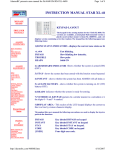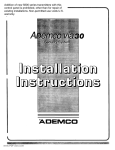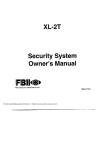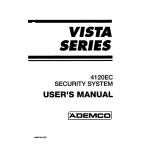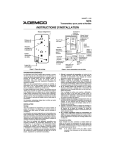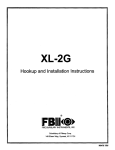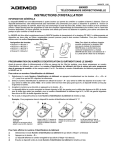Download XL-2 Gold User Manual - Affordable Security and Protection
Transcript
XL-2 Gold N9475 Rev.A 8/95 Quick Reference TURN SYSTEM ON Check to make sure the system is READY - Green ready light is lit Enter your four digit user code ❑ IDU13 The On/Off (Arm) light will light Exit through a door designated by your installer as an exitientry door. TURN SYSTEM OFF Enter through a door designated by your installer as an exiffentry door. Enter your four digit user code ❑ 000 The System On (Arm) light will go out TURN SYSTEM ON AND STAY INSIDE Check to make sure the system is READY - Green ready light is lit ml Followed by your user code ❑ lclclcl The On/Off (arm) light and the Stay light will both light REMEMBER: You must turn the system off if you want to open the door or leave the premises after the exit time has passed. TURN THE SYSTEM ON: PERIMETER INSTANT MODE AND STAY INSIDE SENSORS Check to make sure the system is READY - Green ready light is lit ~ ‘“ltowed by w~ followed by your user code ❑ ❑ ❑ ❑ The On/Off light, the Instant light and the Stay light will all be on SMOKE DETECTOR RESET Enter your four digit user code ALARM COMPANY ❑ unn SERVICE NUMBER Introduction Congratulations on your decision to protect your home or business with the XL-2G security system. You have chosen a reliable, state of the art security system that is remarkably easy to operate. Your system has been professionally installed by your local Security Company who can explain the specifics of your system. The keypad is the input and display device for your security system. The following keypad models can interact with your system. Your Security Company will suggest the model most appropriate for your premises and your needs. XL-4600SM — A surface mount keypad containing indicator lights for each of the 6 zones (areas of protection). The door covering the buttons is optional and can be removed. 6805 — Keypad with a plastic case and a two line English read-out LCD (liquid crystal display), Status messages for the zones (areas of protection) are displayed in simple English. The XL-2G is listed by Underwriters Burglary applications. Laboratories Throughout this manual the following conventions keystrokes required to perform the functions. for Household Fire and are used to display the - Button labeled BYPASS - Button labeled INSTANT - Button labeled STAY - Button labeled CODE - Four digit user code Please keep your manual in a convenient needed. location so you can refer to it if XL-2G User Manual - Page 1 SYSTEM REFERENCE ZONE PROTECTED AREA 1 2 3 4 5 6 Entry time Door Entry time Door ASSIGNED USER ID Exit time TO l_ (MASTER USER *) 2 3 4 5 6 ‘Master Ambush/Duress Code -Yesa Non lfNo _ User can Add, Change, or Erase other user codes. The following SEND HELP ALERTS are programmed into my system. Both Buttons must be pressed at the same time to activate the alert. BUTTONS DESCRIPTION Left Center Right Monitoring Station Information Account # Telephone # XL-2G User Manual - Page 2 TURNING THE SYSTEM ON You can turn the Burglar portion of your security system on and off. Before you turn the system on it must be ready. If you have a protected door open, or someone is moving by a motion detector the system will not show ready The system is ready if the ready light is on or if the display shows: I SYSTEM READY I TURN THE SYSTEM ON AND LEAVE ❑ unn Enter your four digit user code The System On (Arm) light will goon or the display will show: ON: AWAY ........ Exit through a door designated by your installer as an exit/entry door. You must leave within the period of time known as the exit time. Check the reference sheet for the time that has been set for your system. NOT READY If the system is not ready to be armed the READY light will be off and the Zone lights will show which zone or zones are not ready. The zone lights indicate the following conditions or the display will show as below: Alarm Fast Blink Slow Blink/Low Bypass Intensity Trouble Slow Pulse Not Ready Solid On Example: If the Ready light is not lit and the zone one light is solid on. An alarm sensor on zone one is not normal. This might mean that a window is open or someone is walking through a motion sensor. Check all sensors on zone one and resolve the problem. When all sensors are normal the Ready light will come on and the zone light will go out. Display shows: SYSTEM NOT READY I TO TURN THE SYSTEM ON - NOT READY Determine which zone or zones is not ready, resolve the problem and turn the system on normally. If the problem cannot be resolved you may bypass the zone that is not ready. Bypassing should only be done if the problem on the zone cannot be resolved OR if you intentionally wish to leave the XL-2G User Manual - Page 3 zone off. Example: you wish to keep the window open for ventilation. Zones that are bypassed are not protected when the system is on. See Bypass for the correct procedure. TURN SYSTEM ON AND STAY INSIDE To turn the perimeter portion of your burglar alarm on and move around freely inside is the STAY mode. Check to make sure the system is READY; when ready press: ml Followed by your user code ❑ lclcln If successful the On/Off (arm) light will be lit and the Stay light will also be lit or the display shows: ON: STAY REMEMBER: You must turn the system off if you want to open the door or leave the premises after the exit time has passed. TURN THE SYSTEM ON: PERIMETER INSTANT MODE AND STAY INSIDE SENSORS In INSTANT STAY mode the perimeter portion of your burglar alarm system is on and the time delays are eliminated from your normal entry/exit door(s). All interior protection is off so you are free to move around inside. Check to make sure the system is READY, when ready press: followed by followed by your user code ❑ 000 If successful the On/Off light, the Instant light and the Stay light will all be on or the display shows: ON: STAY INSTANT BYPASS Bypass excludes a zone or zones of protection from your security system. Bypassing can only be done while the system is turned off. Press the Bypass Button followed by your user code and then the Zone # (1-6) to be bypassed. ml ❑ unn ZONE NOTE: Bypassed zones are not protected when the system is turned on. After the bypass command has been accepted the keypad will sound one long beep and the zone or zones bypassed will slowly blink or the display shows: XL-ZG User Manual - Page 4 I BYPASS FRONT DOOR ZN 01 I NOTE: Temporary users (i.e. baby sitters, housekeepers, be shown the Bypass procedure. etc.) should not Bypassed zones will automatically be included in the system again when you turn the system off. You may also manually unbypass (put the zone back into the system) by repeating the bypass function. UNBYPASS Unbypass returns a bypassed zone to normal operation. Unbypass is a repeat of the bypass function. ~1 After unbypassing ❑ DUD ZONE the zone display will show the state of the zones. TURN THE SYSTEM OFF When you turn off the system you turn off only the burglar portion of your system, any smoke or heat detectors and panic buttons will remain on. You must enter through a designated entry door and turn off the system within the time allowed. You can have different amounts of time for different entry points. See your system reference sheet for the times established for your system. Enter your four digit user code ❑ 000 If no alarms have taken place, the On/Off light (labeled arm) will go off or the display shows: If alarms occurred when the system was on, or if a trouble condition exists they will display on the zone indicator lights as follows: Fast Blink Slow Blink/Low Alarm Intensity Bypass Slow Pulse Trouble Solid On Not Ready or the display shows: Burglary Alarms will sound a steady sound through the keypad(s) alarms will generate a pulsing sound. and fire Important: If an intrusion has taken place while you were away, do not enter until the location has been checked. Call for help from a neighbor’s house and wait for the police. XL-2G User Manual - Page 5 After you have turned the system off with your user code the message on display keypads will show: To clear the display of the alarm or trouble conditions and silence the audible alert : Enter your four digit user code ❑ 000 again. USER CODES ADD OR CHANGE A USER CODE Users can be entered or modified directly through the keypad. Your system can have up to 6 different User Codes. User #1 is the Master User and is the only one allowed to add, or delete other users. Press the Code button followed by the four digit master user code then the user # and the new four digit user code. The keypad will beep after each digit is pressed. Master User Code m ❑ 000 User ID us New User Code Clrlnrl The system reference page will help you plan and record your users. On this sheet your installer will indicate if you have chosen to dedicate a user code to send an emergency signal in the case of Ambush or Duress. DELETE A USER CODE To delete user #3, press the code button followed by the four digit master user code, then the user # then’ to delete. ~ tvt~t~~~e U;rll) ~delete NOTE: User #1, the master user, cannot be deleted but it can be changed using the ADD OR CHANGE USER PROCEDURE. KEYPAD SEND HELP CONDITIONS Your system can be programmed for 3 separate Send Help Alerts which would send an emergency signal to your central station. See System Reference sheet to see which have been programmed for your system. Duress Your system can be programmed to send an emergency signal to the Central Station if you are forced to enter the premises. If you choose to include this feature, User Code number 6 is dedicated to this function and must only be used under a duress circumstance. XL-2G User Manual - Page 6 ❑ Quick On - (Q uick Arming) Yes ❑ No If programmed by your installer, QUICK ON, or Quick Arming allows you to turn the system on to the away mode without user code. NOTE: Turning your system Off always requires a valid User Code. #1 Quick Forced On - Yes ❑ No ❑ If programmed by your installer Quick Forced On, allows you to turn the burglar portion of your alarm system on to the away mode automatically bypassing all zones that are not ready. #2 NOTE: A valid user code is still required to turn the system off. NOTE: This feature is disabled on UL installations. Quick Bypass Yes ❑ No ❑ If you have quick bypass programmed for your system you will not have to use your user code to bypass zones. The quick bypass procedure is: -l ZONE (,-6) NOTE: Bypassed zones are not protected when the system is turned on. After the bypass command has been accepted the keypad will sound one long beep and the zone or zones bypassed will slowly blink or the display will show: BYPASS FRONT DOOR ZN 01 NOTE: Temporay users (i.e. baby sitters, housekeepers, be shown the Bypass procedure. etc.) should not Turn Chime On/Off Chime is an optional feature that causes the keypad to chime when selected doors are opened when the burglary protection is off or disarmed. Only your installer can program a zone for the chime feature, but once programmed you can turn chime on or off to meet your daily needs. To turn chime on or off. Press #6 XL-2G User Manual - Page 7 im ON/OFF (ARM/DISARM) When lit, burglar portion of system is on. When off, the burglar system is off. Blinking LED indicates communication failure. Check to see if your phones are working. STAY Indicates the system is on with interior zones Wher electr thes! stand see if if so, btow] excluded so you can move around freely ARM inside the premises. BTAY / I llU8fANT / AC/LB READY I READY When lit, system is ready to be turned on. When off, check zone status indicators to see which zone is not ready. ~x Slow Blink/Low Intensity I w Bypass E SOUNDER The sounder in the keypad beeps whenever the keypad keys are pressed. The sounder also beeps when the system is on and you open a delay door as a warning to remind you to turn the system off. The sounder will produce fast beeps when a message is received by the central station. It is important to be careful when turning the system on, because if the system is not ready and the user code is entered the keypad will beep 4 times showing that there is a problem and that the system has not accepted your request. FIRE PROTECTION Fire protection is always active and Fire conditions are given priority. 1BAITERY your system is running on y (AC power). When off, ?m is running on the battery. If off, check to 3 system is plugged in and Ike sure you have not Ie fuse or circuit breaker. / I I l-l ml rim m l-m ml 1=1 l-m \ COVER (OPEN) rrl FUNCTION BUITONS Used for system input. I SEND HELP BUTTONS \ I P] I — . I D To activate, both top and bottom buttons must be pressed at the same time. l\ Audible and Visual indicators. On LED keypads the programmed fire zone LED and the ARM LED will blink fast to indicate a fire alarm. The sounder in the keypad will pulse on and off following the bell or siren output. READY LED A FLASHING ready LED indicates that the system is in the installer programming mode. The Fire and Burglary zones are disabled while in this mode. Contact your installation company if mode persists. INSTALLATION Early warning fire detection is best achieved detection equipment in the location as follows: r Typical Smoke Detector Layout mP-O 9fclnO(w LAYOUT by the installation OnuuG of fire w rMuMm etlmlm.lu II,lcMt* A. u!tmOOM acoatmu Wnall (ml , *“W. ,,, IIw m i F In homes with more than one sleeping area a smoke detector should be provided to protect each area. Smoke detectors shall be located between the sleeping area and the rest of the house. NOTE Refer to N. F.P.A. 874 Appendix B1.1 through B-1 O. In the diagram a + represents a smoke detector. Preparation of an evacuation plan is of prime importance in fire prevention. Establish a household or business emergency evacuation plan to be followed in the event of a fire. 1. Evaluate possible escape routes from your home or business. 2. Select 2 escape routes from each room. 3. Rooms on the second floor should have a rope ladder (make sure it reaches the ground) or fire escape. 4. Draw a rough sketch of your escape plan so everyone is familiar with it. 5. Practice your escape plan to make sure everyone knows what to do. 6. Establish a meeting place outside where everyone will meet. 7. Advise the local fire authority that you have installed a fire alarm system. 8. When the fire alarm signals, LEAVE IMMEDIATELY. belongings. Do not stop for 9. If a fire occurs, test the door. if hot, use your alternate route. If the door is cool, brace your shoulder against it and open it cautiously. Shut the door to help prevent the fire and smoke from spreading. Crawl through smoke holding your breath. 10. Contact the Fire Department from a neighboring 11. Everyone, including neighbors, Burglary audible alarm sounders. Fire Alarm Sound should be familiar with your Fire and is: Burglar Alarm Sound is: XL-2G User Manual - Page 10 -. house or business. SYSTEM LIMITATIONS LIMITATIONS OF THIS ALARM SYSTEM While this system is an advanced design security system, it does not offer guaranteed protection against burglary, fira, or other emergancy. Any alarm system, whether commercial or residential, is subject to compromise or failure to warn for a variety of reasons. For example: @ Intruders sophistication may gain access through unprotected openings or have the technical to bypass an alarm sensor or disconnect an alarm warning device. @ Intrusion detectors (e.g. passive infrared detectors), smoke detectors, and many other sensing devices will not work without batteries, or if the batteries are not put in properly. Devices powered solely by AC will not work if their AC power supply is cut off for any reason, however briefly. 0 Signals sent by wireless transmitters maybe blocked or reflected by metal before they reach the alarm receiver. Even if the signal path has been recently checked during a weekly test, blockage can occur if a metal object is moved into the path. @ A user may not be able to reach a panic or emergency button quickly enough. O While smoke detectors have played a key role in reducing residential fire deaths in the United States, they may not activate or provide early warning for a variety of reasons in as many as 35% of all fires according to data published by the Federal Emergency Management Agency. Some of the reasons smoke detectors used in conjunction with the System may not work are as follows: Smoke detectors may not sense fires that start where smoke cannot reach the detectors, such as in chimneys, in walls, or roofs, or on the other side of closed doors. Smoke detectors also may not sense a fire on another level of a residence or building. A second floor detector, for example, may not sense a first floor or basement fire, Moreover, smoke detectors have sensing limitations. No smoke detector can sense every kind of fire every time. In general, detectors may not always warn about fires caused by carelessness and safety hazards like smoking in bed, violent explosions, escaping gas, improper storage of flammable materials, overloaded electrical circuits, children playing with matches, or arson. Depending on the nature of the fire and/or the location of the smoke detectors, the detector, even if it operates as anticipated, may not provide sufficient warning to allow all occupants to escape in time to prevent injury or death. @ Passive Infrared Motion Detectors can only detect Intrusion within the designed ranges as diagramed in their Installation Manual. Passive Infrared Detectors do not provide volumetric area protection. They do create multiple beams of protection, and intrusion can only be detected in unobstructed areas covered by the beams. They cannot detect motion or intrusion that takes place behind walls, ceilings, floors, closed doors, glass partitions, glass doors or windows. Mechanical tampering, masking, painting or spraying, of any material on the mirrors, windows or any part of the optical system can reduce their detection ability. Passive Infrared Detectors sensa changes in temperature; however, as the ambient temperature of the protected area approaches the temperature range of 90 degrees to 150 degrees Fahrenheit, the detection performance can decrease. @ Alarm warning devices such as sirens, bells or horns may not alert people or wake up sleepers who are located on the other side of closed or partly open doors. If warning devices sound on a different level of the residence from the bedrooms, then they are less likely to waken or alert people inside the bedrooms. Even persons who are awake may not hear the warning if the alarm is muffled by noise from a stereo, radio, air conditioner, other appliances, or by passing traffic. Finally, alarm warning devices, however loud, may not warn hearing-impaired people or waken deep sleepers. @ Telephone lines needed to transmit alarm signals from a premises to a central monitoring station may be out of service or temporarily out of service. Telephone lines are also subject to compromise by sophisticated intruders. XL-2G User Manual - Page 11 @ However, even if the system responds to the emergency as intended occupants may have insufficient time to protect themselves from the emergency situation. In the case of a monitored alarm system, authorities may not respond appropriately. @ This equipment, like other electrical devices, is subject to component failure. Even though this equipment is designed to last as long as 10 years, the electronic components could fail at any time. The most common cause of an alarm system not functioning when an intrusion or fire occurs in inadequate maintenance. This alarm system should be tested weekly to make sure all sensors are working properly. Installing an alarm system may make one eligible for lower insurance rates, but an alarm system is not a substitute for insurance. Homeowners, property ownersand rentersshould continue to act prudentlyin protectingthemselves and continue to insure their lives and property. We continue to develop new and improved protection devices. Users of alarm systems owe it to themselves and their loved ones to learn about these developments. XL-2G User Manual - Page 12 GLOSSARY Small green light between the center buttons on the keypad. When lit, the system is running on electricity; when not lit, the system is running on the backup battery. AC INDICATOR: ALARM: Sound from keypad or other horn/siren indicates a burglar alarm, fire alarm or other condition you should be alerted to. ARMED: See ON/OFF AWAY A systemsettingthatprotectsthe premiseswhileit isunoccupied.Allburglarysensors are active. BURGLARY/FIRE: The two major functions of a Security System. Fire protection is always on and cannot be turned off. The Burglary sensors protect against unauthorized entry into your premises. The Burglary protection can be turned on and off and programmed for special levels of access and notification. BYPASS FEATURE: The Bypass Feature allows you to exclude a selected zone or zones from the burglar alarm protection. BYPASS BUITON: A button on the keypad used to activate the Bypass Feature. CENTRAL STATION: Signal Monitoring Center contacted by your Security System over the telephone and/or other communication channels when alarms are activated if your system is programmed to communicate alarms off site. The Central Station will follow their procedures and your instructions for contacting the proper authorities when a signal is received. CHIME FEATURE: An optional feature that causes the keypad to chime for one second when selected doors are opened when the burglary protection is off or disarmed. Once programmed by your installer you can turn chime on and off with #6. DISARMED: See ON/OFF. DURESS: Duress is a system feature the you may have programmed into your system. If someone should force you to turn your system off, you would use the special Duress user code and the system would turn off and it would also send a silent duress emergency to the Central Station so they could respond appropriately. ENTRY DELAY: The period of time allowed between opening a designated entry/exit door and turning off the alarm system before the system will register an alarm condition. This is determined at the time of installation. Your system supports two entry times allowing you to have a different length of time for different doors. EXIT DELAY: The period of time allowed between turning the system on and leaving through a designated exitientry door. This is determined at the time of installation. INTERIOR ZONE: An interior zone is a group of points that protect the interior of your premises. You may want to turn the perimeter portion of your system on while leaving the interior zones off allowing you to move freely inside, opening interior doors and passing by motion detectors without causing an alarm. KEYPAD: A Keypad is your link into your system. It displays alarm and trouble messages, shows faulted zones and allows you to turn the system on/off by using the buttons. Your system will have one or more keypads. ON/OFF: These terms refer to the burglary portion of your security system. There are several levels of operation which allow you to protect part of your premises while you remain inside. Fire sensors and other emergency and environmental conditions are always active and ready and are not affected in any way by turning the burglary portion of your Security System on or off. Armed, a term that is sometimes used means system on and Disarmed means system off. See ON-INSTANT, ON-STAY and STAY. ON/OFF INDICATOR: Red light in the upper portion of the keypad labeled Armed. When lit, some part of the burglar alarm system is on; when not lit, the burglary portion of the system is off. XL-2G User Manual - Page 13 ON-STAY: movement A system setting that turns on the perimeter protection of the building but allows throughout the inside. PANIC BUITON: A pus~ button which allows you to signal the Central Station that you need immediate assistance. Your system has programmable Keypad Send Help Alerts which can also serve as Panic buttons. PERIMETER ZONE: A perimeter zone is a group of points that protect the exterior of your premises. Your outside doors and windows would be programmed as a perimeter zone. SENSOR: The actual alarm sensor, detector or device installed to detect an intrusion, fire, or environmental problem. Examples include: door contacts, window contacts, motion sensors, glass break sensors, smoke detectors, rate of rise heat detectors, temperature sensors, flood/water sensors, and carbon monoxide gas detectors, SILENT CONDITION: Most types of alarms and troublesaleti you withthe keypad sounder and the sirens, horns, or speakers located in your premises. The intent is to advise you of the alarm or trouble and allow you to respond promptly. The audible sounds also let an intruder know that they have been detected and will hopefully scare them away. In some circumstances, an audible alarm might put your life in danger and so those alarms are programmed as silent conditions. For an example see DURESS. SYSTEM: Your Security Syd~em is composed of three main parts: 1) the Control Panel which functions as the system brain and the link to the Monitoring Agency (Central Station), 2) the Keypad(s) which provide you with system status and allow you input commands, 3) Security Sensors such as door and window contacts, motion sensors, smoke detectors and other sensors as required to detect intrusion, fire and other conditions as needed for your premises. USER CODE: A user code is a 4 digit code system supports up to 6 separate user codes. add/delete other user codes. Two of the user defined by your alarm company at the time of of this manual) which is required to operate the system. The The system supports one master user who can codes maybe dedicated to special functions as installation. (Seethe User Code List in the back ZONE: A zone is a collection of sensors with common characteristics grouped together for your operating convenience. The system will suppori 6 zones or groupings. XL-2G User Manual - Page 14 FEDERAL COMMUNICATIONS COMMISSION (FCC) STATEMENT This equipment has been tested to FCC requirements and has been found acceptable for use. The FCC requiresthe followingstatementfor your information: This equipment generates and uses radio frequency energy and if not installed and used properly, that is. in strict accordance with the manufacturer’s instructions, may cause interference to radio and television reception. It has been type tested and found to comply with the limits for a class B computing device in accordance with the specifications in Subparl J Part 15 of FCC Rules, which are designed to provide reasonable protection against such interference in a residential installation. However, there is no guarantee that interference will not occur in a particular installation. If this equipment does cause interference to radio or television reception, which can be determined by turning the equipment on, the user is encouraged to try and correct the interference by one or more of the following measures: @ If using an indoor antenna, have a quality outdoor antenna installed. @ Re-orient the receiving antenna until interference is reduced or eliminated. @ Move the receiver away from any wire runs to the controlkommunicator. @ Plug the control/communicator different branch circuits. into a different outlet so that it and the receiver are on If necessary, the user should consult the dealer or an experienced for additional suggestions. radio/television technician The user or installer may find the following booklet prepared by the Federal Communications Commission helpful: “Interference Handbcd”. This booklet is available from the U.S. Government Stock No. 004-000-00450-7. Printing Office, Washington, DC 20402. The user shall not make any changes or modifications to the equipment unless authorized by the installation Instructions or User’s Manual. Unauthorized changes or modifications could void the user’s authority to operate the equipment. TELEPHONE OPERATIONAL PROBLEMS In the event of telephone operational problems, disconnect the control by removing the plug from the RJ31X wall jack. We recommend that your certified installer demonstrate disconnecting the phones on installation of the system. Do not disconnect the phone connection inside the control/communicator. Doing so will result in the loss of your phone lines. If the regular phone works correctly after the control/communicator has been disconnected from the phone lines, the control/communicator has a problem and should be returned for repair. If upon disconnection of the controVcommunicator, there is still a problem on the line, notify the telephone company that they have a problem and request prompt repair service. The user may not under any circumstances (in or out of warranty) attempt any service or repairs to the system. It must be returned to the factory or an authorized service agency for all repairs. SYSTEM TESTING This control unit was manufactured under rigid quality standards and complies with all UL requirements for its intended use. Maintenance is best performed by your installing company with trained service personnel. XL-2G User Manual - Page 15 LIMITED WARRANTY Fire Burglary Instruments, Inc,. a subsidiary of Pitway Corporation, and Pitway Corporation, its divisions, subsidiaries and affiliates (“Seller”), 149 Eileen Way, Syosset, New York 11791, warrants its security equipment (the “product”) to be free from defects in material and workmanship for five years from date of original purchase, under normal use and service. Seller’s obligation is limited to repairing or replacing, at its option, free of charge for parts, labor, or transportation, any product proved to be defective in materials or workmanship under normal use and service. Seller shall have no obligation under this warranty or otherwise if the product is altered or improperly repaired or serviced by anyone other than the Seller. In case of defect, contact the security professional who installed and maintains your security equipment or the Seller for product repair. This five year Limited Warranty is in lieu of all other expressed warranties, obligations or liabilities. THERE ARE NO EXPRESS WARRANTIES, WHICH EXTEND BEYOND THE FACE HEREOF. ANY IMPLIED WARRANTIES, OBLIGATIONS OR LIABILITIES MADE BY SELLER IN CONNECTION WITH THIS PRODUCT, INCLUDING ANY IMPLIED WARRANTY OF MERCHANTABILITY, OR FITNESS FOR A PARTICULAR PURPOSE OR OTHERWISE, ARE LIMITED IN DURATION TO A PERIOD OF FIVE YEARS FROM THE DATE OF ORIGINAL PURCHASE, ANY ACTION FOR BREACH OF ANY WARRANTY, INCLUDING BUT NOT LIMITED TO ANY IMPLIED WARRANTY OF MERCHANTABILITY, MUST BE BROUGHT WITHIN 60 MONTHS FROM DATE OF ORIGINAL PURCHASE. IN NO CASE SHALL SELLER BE LIABLE TO ANYONE FOR ANY CONSEQUENTIAL OR INCIDENTAL DAMAGES FOR BREACH OF THIS OR ANY OTHER WARRANTY, EXPRESS OR IMPLIED, OR UPON ANY OTHER BASIS OF LIABILITY WHATSOEVER, EVEN IF THE LOSS OR DAMAGE IS CAUSED BY THE SELLER’S OWN NEGLIGENCE OR FAULT. Some states do not allow limitation on how long an implied warranty lasts or the exclusion or limitation of incidental or consequential damages, so the above limitation or exclusion may not apply to you. Seller does not represent that the product may not be compromised or circumvented; that the product will prevent any personal injury or property loss by burglary, robbery, fire or otherwise; or that the product will in all cases provide adequate warning or protection. Buyer understands that a properly installed and maintained alarm may only reduce the risk of a burglary, robbery, fire or other events occurring without providing an alarm, but it is not insurance or a guarantee that such will not occur or that there will be no personal injury or property loss as a result. CONSEQUENTLY, SELLER SHALL HAVE NO LIABILITY FOR ANY PERSONAL INJURY, PROPERTY DAMAGE OR OTHER LOSS BASED ON A CLAIM THE PRODUCT FAlLED TO GIVE WARNING. HOWEVER, IF SELLER IS HELD LIABLE, WHETHER DIRECTLY OR INDIRECTLY, FOR ANY LOSS OR DAMAGE ARISING UNDER THIS LIMITED WARRANTY OR OTHERWISE, REGARDLESS OF CAUSE OR ORIGIN, SELLER’S MAXIMUM LIABILITY SHALL NOT IN ANY CASE EXCEED THE PURCHASE PRICE OF THE PRODUCT, WHILE SHALL BE THE COMPLETE AND EXCLUSIVE REMEDY AGAINST SELLER. This warranty gives you specific legal rights, and you may also have other rights which vary from state to state. No increase of alteration, written or verbal, to this warranty is authorized. XL-2G User Manual - Page 16 SYSTEM TEST It is recommended that you test your system once a week using the following procedure: NOTE: If your system is monitored, contact your Central Station before you perform this test. 1. Turn your Security System on. 2. Wait until your exit time is over and them activate the system by opening a protected zone. (For example: a window or door). 3. Confirm that the alarm sounding device (bell or siren) sounds. If your system is connected to a central station the keypad will sound the ringback tone to confirm that the signal was received. 4. Turn the Security System off. 5. Call the Central Station to tell them you are done testing. BATTERY TEST Itis recommended that you test your Battery once a month. In order to test your backup/standby battery, the following procedure should be followed: 1. Unplug the transformer from the AC outlet by removing the restraining screw which secures the transformer to the wall. (Note: the screw is not present on the models sold in Canada.) 2. Observe that the AC indicator light on the keypad goes off. 3. Activate your alarm by performing the above SYSTEM TEST. Remember to contact your Central Station if your system is monitored. 4. Plug the transformer into the AC outlet and secure with the restraining screw. (Note: the screw is not present on the models sold in Canada.) The National Fire Protective Association publishes a standard for fire warning equipment (NFPA publication #74). Further information can be obtained by contacting: NFPA Public Affairs Dept., Batterymarch Park, Quincy, MA 02269. If you have any further questions alarm company. about the operation of your system, please contact your






















